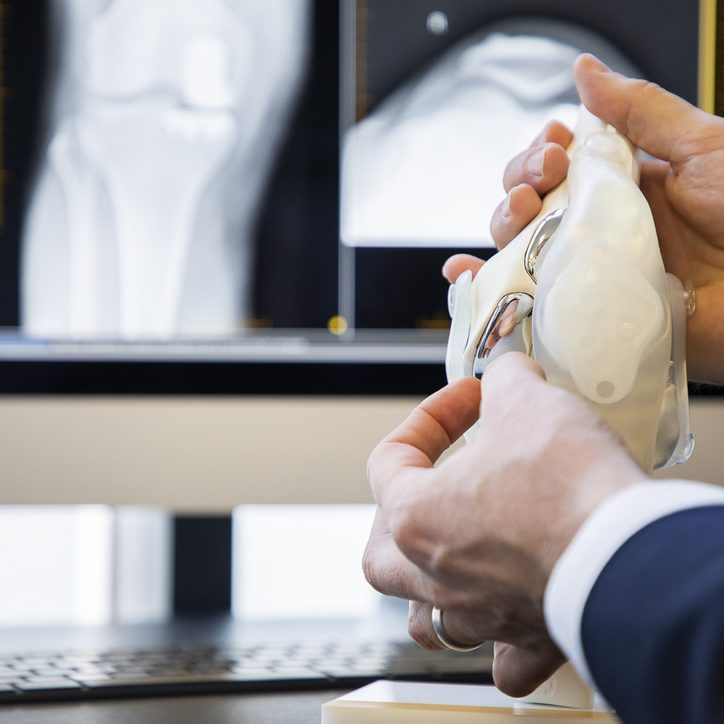Partial Knee Replacement (Uni knee)
This surgical option has faster recovery and can be done through a smaller incision, when compared to a total knee replacement.
In select patients with osteoarthritic disease limited to only one compartment, a unicompartmental knee replacement (also known as a partial knee replacement) may be suitable.

In osteoarthritis, the cartilage on the articulating surfaces of the bones wears away which can cause pain. The three main compartments of the knee include the medial (inside of the knee), lateral (outside of the knee), and patellofemoral (under the kneecap) compartments. The majority of patients with severe knee osteoarthritis requiring surgery will require a total knee replacement. However, in select patients with osteoarthritic disease limited to only one compartment, a unicompartmental knee replacement (also known as a partial knee replacement) may be suitable.
This surgical option has a faster recovery and can be done through a smaller incision when compared to a total knee replacement.
During your appointment, a thorough clinical examination and history will be performed. Imaging with X-rays will aid in characterising the nature and severity of arthritis and if a unicompartmental knee replacement would be suitable for you.
With any operation, we will ensure that we prepare you preoperatively to ensure that an optimal surgical outcome is achieved.
Strengthening of the muscles around the knee is strongly recommended. At MTP Health we have tailored pre-operative and post operative rehabilitation programs to support you with achieving an optimal outcome.
Your anaesthetist will also assess your medical history and determine the most suitable anaesthetic regime. Any ongoing medical issues will be optimised prior to surgery to ensure the procedure can proceed safely.
The operation will be performed under a general or spinal anaesthetic. A small incision will be made over the knee to expose the knee compartment that is damaged. The arthritic ends of the femur (thighbone) and tibia (shinbone) will be removed using specialised saws. These ends will be replaced with new metal components, which are typically secured in place using bone cement. In between the new metal components of the femur and tibia, a polyethylene spacer will be inserted that provides a smooth gliding surface. The positioning of the implant is checked prior to closing the surgical incision with sutures and covered with dressings.
You will be taken to the post-operative recovery room immediately following the surgery to allow you to recover from the anaesthesia. You will be monitored closely here until you are comfortable and your vitals stable. After this you will be transferred back to the ward to begin your recovery and rehabilitation process. Typically, patients will be able to discharge home after 1-3 days, with some patients even going home the same day as the surgery.
As this procedure involves replacement of only one compartment, there is less soft tissue and bony disruption during the operation compared to a total knee replacement. As a result, there is often less pain and swelling, allowing for quicker rehabilitation. You will immediately be able to start bearing weight through the knee after the surgery. Walking can initially be difficult and you may require the assistance of a walker or crutches for a short period of time. Our MTP physiotherapists will also give you exercises to perform at home. For the first 2 weeks after the operation, the goal is to start walking independently again and maintain knee range of motion. Strength will gradually return and by 6 weeks post-operation you will be able to return to most activities of daily living.
Return to driving
Returning to driving takes a minimum of six weeks for right knee surgery and two weeks for left knee surgery in an automatic car. You must be able to safely perform an “emergency stop” and you must have stopped all painkillers other than over-the-counter medications (such as Panadol or Nurofen). There is no specific documentation on this by licensing authorities, but checking with your car insurance company is recommended.
All surgery involves a risk of complications. Fortunately, serious complications are uncommon.
With any operation there will always be risks, which include both surgical and general complications. Infection, blood clots (deep vein thrombosis and pulmonary embolism) and allergic reaction to anaesthetics can occur in a small minority of cases. Surgical complications include damage to nerves or blood vessels, and fracture of the bones while inserting the implant. There is also a risk of implant loosening or further progression of arthritis in the other compartments. If this were the case, then a unicompartmental knee replacement can be converted to a total knee replacement.
As always with the health system, the answer is ‘It depends.’
However, at MTP Health our mission is to simplify healthcare through a better understanding of the system upfront. Therefore, while you can discuss the options specific to you with the team when you see your specialist -
If you are having your surgery using your private health cover then the standard fees for the surgeon, the anaesthetist and the assistant will usually lead to a total out of pocket payment of approximately $4,500-5,000.
This is the ‘GAP’ that is left after Medicare and your insurance company have given you back their rebates. It is important to stress that the anaesthetist is an independent practitioner and can charge a different gap which could affect this figure. We always provide you with their details and recommend you check their quote before committing to surgery.
The surgeons at MTP Health do participate in the various reduced gap schemes run by different health insurance providers. However, please check for availability of surgical time slots first as there is often a wait of many months for this option.
Your insurance may also have an excess to pay so please check. This is usually $500.
If you are having the operation under the public system there is no out of pocket cost. Unfortunately, you are likely to have to wait up to a year for surgery.
